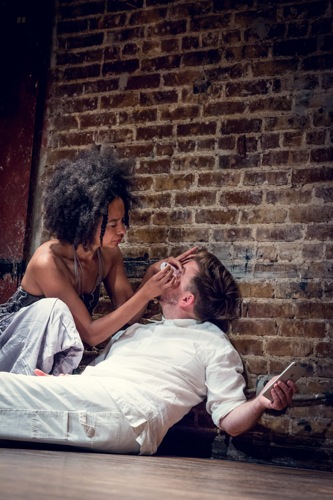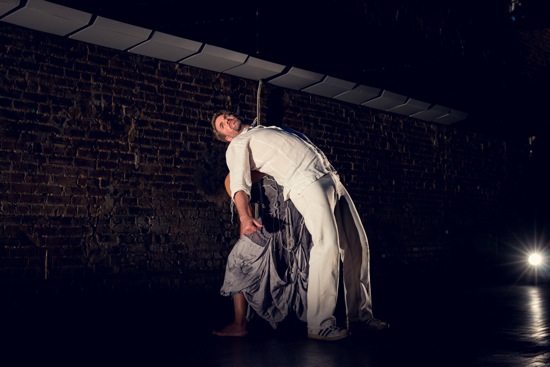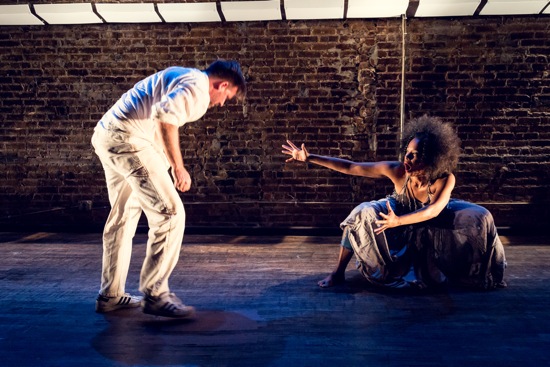Jane Comfort and Company and Jon Kinzel present new works.
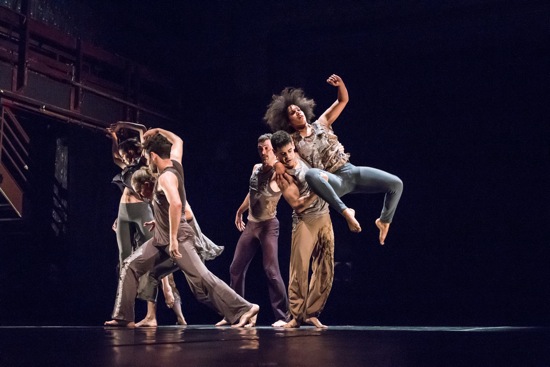
Jane Comfort’s Altiplano
(L to R): Gabrielle Revlock (hidden), Ellen Smith Ahern, Petra van Noort, Darrin Wright, Sean Donovan, Javier Perez, Leslie Cuyjet. Photo: Lim Jinyoui
Jane Comfort is a master teller of tales—not straight linear narratives, but dances that bristle with content—often social and/or political, often involving spoken text. She has always ingeniously layered and juxtaposed elements and viewpoints that might strike anyone else as incompatible and made them ignite one another. Her 1988 Cliff Notes Macbeth and 2010 Faith Healing were wickedly revealing takes on major plays (the second tackled Tennessee Williams’s Glass Menagerie). She pulled gender apart in S/He (1995)—appearing as a gutsy male alongside a drag queen. Her American Rendition (2008) braided two meanings of the word into a work both terrifying and hilarious (rendition as in a song delivered in tv talent contest, rendition as the practice of transporting suspected terrorists for interrogation in countries that condone torture). In the beautiful and moving 1998 Underground River, a child in a coma gradually sinking away from life is embodied by four unified performers.
Her new Altiplano premiered May 28-31 in La MaMa’s Ellen Stewart Theater, during the annual LaMama Moves! Dance Festival curated by Nicky Paraiso. Comfort announced Altiplano as a move into new territory: a dance primarily about movement and the architecture that supports it. The going off and on again of two big round lights pointing toward us indicate section divisions. Comfort would like us to understand that this fascinating piece (a collaboration with composer Brandon Wolcott, lighting designer Joe Levasseur, costume Designer Liz Prince, and seven marvelous performers) tells no overarching “story,” nor does it proffer a “situation.” She is, however, incapable of making the kind of work people like to call abstract, and for that I’m grateful.
She has collected resonant images associated with high plateaus of South America, folded them into passages of dancing, and molded the whole via repetition and variation and all the other attributes of a dance “about” dancing. You can certainly see what could become stories, but don’t. Altiplano introduces the sense of a place where water is scarce—a vast open space alive with potential dangers for its inhabitants. And by inhabitants, I mean not only human beings, but creatures and plants large, and pungent hints of the natural forces that threaten their lives and the rituals that sustain them.
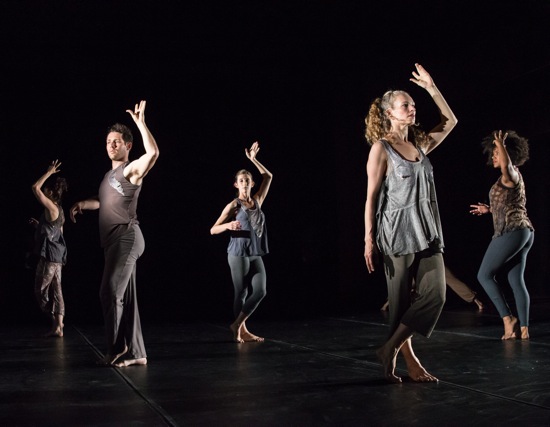
(L to R): Gabrielle Revlock, Darrin Wright, Ellen Smith Ahern, Petra van Noort, and Leslie Cuyjet in Altiplano. Photo: Lim Jinoui
Some of the actions and gestures are more tightly pinned to what they represent than others. When, say, Leslie Cuyjet stands with her arms raised to her sides, then bent squarely at the elbows, you might think of saguaro standing like prickly desert sentinels. Or you might not. When Sean Donovan crawls in on his hands, dragging his bent legs behind him and darting his eyes around, you think of an iguana or some kind of lizard, but don’t look for exact resemblance. Ellen Smith Ahern, Gabrielle Revlock, and Petra van Noort, dancing in unison, cup their hands slightly and pass them down in front of their mouths, you may or may not see them as drinking water, but when, in the course of a duet, Cuyjet and Donovan crouch down together and dip their heads to the floor, you can’t not think “drinking.”
But these elements, like the dry vocal sounds the dancer make occasionally, are part of a texture that includes recognizable dance moves—springy steps like leaps and bounds, spins. Javier Perez, moving with the others, several times repeats a raspy cry while clutching his throat; thirst patterned.
When Altiplano begins, van Noort is standing alone in a area of soft light. She moves meditatively and with wonderful sensitivity without leaving that spot. She seems to be tending to the air around her and the ground, her gaze focused–surveying the terrain, She could be a shaman of sorts, even if all she’s conjuring up is the dance that will follow. But she also luxuriates in the light—bending, swinging her torso in a circle, opening her chest to the sky. Duets for Cuyjet and Donovan evoke mating animals sizing each other up. But they not only run pressed together spoon-fashion, or nuzzle each other, they also face off intently and recite, in hushed voices, numbers and letters of the alphabet. And in at least one of their encounters, they seem to represent natural elements forcing their way into new configurations: holding her weight on her hands, Cuyjet “walks” her foot up Donovan, a supporting structure, until one foot reaches his neck.
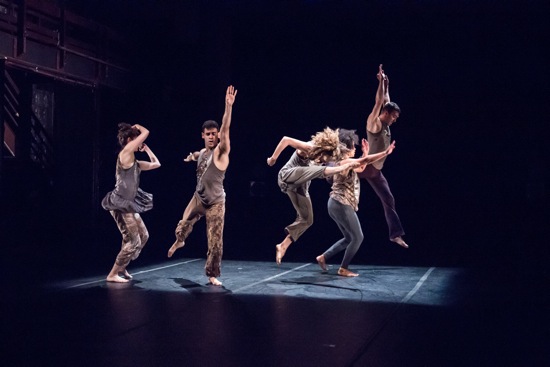
Jane Comfort’s Altiplano. (L to R): Gabrielle Revlock, Javier Perez, Petra van Noort, Leslie Cuyjet, and Sean Donovan. Photo: Lim Jinoui
The travels of the dancers across space can suggest migrations, or winds or watery flow. They roll, and you think tumbleweed. That is, you may think that, or you may think rolling rocks, or you may simply see a movement that contrasts with what has preceded it. Darrin Wright begins one such journey sitting on the floor, the soles of his feet together, and inching his way toward a far corner of the space without altering that position. One by one, the others join him. You watch them swaying from side to side with the effort, while a globe is projected on the back hanging (maybe a moon). Suddenly a deafeningly loud sound explodes. One of the two big lights at the back flashes, and all the performers fall back —again, maintaining their positions, except that the soles of their feet now face the ceiling. Then the atmosphere calms down, and they resume their trek. The disastrous event occurs again; so does their response. They keep slogging along until all but Donovan and Cuyjet are out of sight. Whatever natural phenomenon the sequence channels, it is mysteriously moving.
The strands of Altiplano—atmospheric sounds and lights, the movements that they enhance—weave potent visions of landscape and climate. However formally these are deployed, they also quiver with implications of human behavior. Certainly the performers play/dance together at times—making big, bold moves; springing into the air; standing and shaking violently; pairing up and devising complicated patterns with their limbs. But they perform similarity and difference without rancor or passion.
At the end, the music become denser and louder; what could be electronically altered voices cry out within it. The dancers begin advancing toward the audience, retreating slowly, advancing again, retreating. When van Noort stands in the pool of light where she stood to begin the piece and gestures in much the way she did before, rain begins to fall on the others lined up along the back. They move sensuously in the water. She falls. The lights go out.
Comfort has tried, I think, to do something very difficult. Altiplano hovers and teases at the edges of abstraction, “meaning” shifting among the obvious, the enigmatic, and the hidden. Sometimes that interplay is disorienting, but mostly it draws you into a world that is both unfamiliar yet close to home.
Attending performances during LaMama Moves! can involve regrets as well as pleasant adventures. On several days between May 28 and June 21, you may find dance events happening in each of LaMama’s four performance spaces, sometimes simultaneously. How can one be in two places at once?
Fortunately, Jon Kinzel’s Provision Provision, begins at 10:00 P.M. Kinzel must relish last-minute decisions. The music (by Kinzel and/or Jim Dawson) was determined opening night; so were the costumes (by Liz Collins, Kinzel, and Edisa Weeks). Weeks, who is credited with “considerable collaborative input” performs the piece with him. Kinzel was responsible for the installation: a line of flat, white rectangular objects with lips that is attached fairly high on the narrow Club’s long brick wall.
He must like thwarting expectations. When the audience enters and sits in two rows on the opposite long wall, Kinzel and Weeks are lying on the floor, moving slowly as if half asleep. Is this the piece? No, we’re still brightly lit; they must be warming up, gradually getting to their feet. He checks his cell phone. They confer. A voice seeming to come from the phone, but may coming through an overheard speaker, runs through what sounds like a list of photographs. The two stroll along together, gazing at the phone’s screen; they don’t look happy. She goes. He slides down the wall and, slumping against it, holds the phone out and stares into it.
Just as we’re thinking this is the piece we’ve come to see, the lights brighten, and Paraiso walks in to give the usual LaMama welcome and introduce what we are about to see. After he leaves, back comes Weeks. Now she has shed her athletic jacket and pants to reveal fully the artfully bizarre gown she had on under and over those garments. It’s a sleeveless gray silk dress with a full skirt irregularly draped. Kinzel is attired in a white shirt and trousers.
Weeks apparently comes with a mission: to minister to him with eye drops. This task becomes stranger and stranger. How many eye drops does a guy need to facilitate improved sight? Or maybe visionary sight? Or to convey a togetherness life of convincing ordeals? Weeks gives Kinzel one treatment, then two (this time his head is in her lap). Then she takes hold of his legs and drags him to a new spot on the floor. This time, she delivers the drops from some distance above him, and then from an even more preposterous height. (Did they, I wonder, have to rehearse this a lot? How accurate could she be?). She gets him up, and he wipes his eyes.
The two dancers perform Provision Provision gravely and attentively, almost always watchful of each other—even, at times, wary. (A lot of what happens in the piece is improvised, and that relaxed intensity of focus is crucial to that process.) One activity doesn’t appear to lead to another. Each is just slotted in, the way lunch is slotted into a day. Kinzel plays a rhythm on a soda can stuck in his wide-open mouth; Weeks carefully rolls up a theraband and blows into it. When they’ve about finished, he pinches the end of her “flute,” while she blows, creating a little rhythmic tune.
Here’s another event. Weeks appears from a far corner wearing a pair of shoes that look as if they’d once been part of a production of Aladdin; both toes and heels curve upward. Back and forth across the space, she tests these: first walking on tiptoe, then stomping, then shuffling. That’s that. Shoes off, life goes on.
But what kind of life do these slightly surreal images belong to? And how to parse the title? The same word twice (perhaps since this is a duet), and a multi-sense word at that. Are they provisioning themselves for something, or is the work a paragraph to be attached to something else, such as Kinzel’s body of work up to now? The two are very close to us, and extremely interesting to watch: Weeks a lean, strong, beautiful woman with a fuzzy halo of black hair, Kinzel rough around the edges—a fine dancer who doesn’t look like A Dancer. You can’t help thinking about them: an actual couple in terms of this collaboration and a virtual couple of some sort—maybe one contending with city life and electronic connections. Improbable images nag at me—such as Odysseus, making his way homeward, encountering the enchantress Circe. At other times, I’m moved by the careful tenderness with which they sometimes touch each other.
The wall figures importantly. It’s a place to lean against, collapse against, listen at, write invisible words on. Weeks “sits,” as if on a chair jutting out from it and claps rhythmically while Kinzel dances. He unbuckles his belt, unzips his flies, and lowers his pants just enough to be able to rub his lower back against the bricks. He looks, as always, pensive staring into space. I try not to think of a bear in spring.
Over the course of the dance, Weeks, with Kinzel’s support, takes two of the white objects off the wall and sets them on the floor. It turns out they fit into clear plastic holders, so now the lighting provided by Alexander Fabozzi makes the small space below each of theses a tiny bit brighter.
Both performers express themselves by dancing. Weeks begins her solo as if conjuring forces out of the ground—arms reaching out and curling in, hips swaying; her vibtrating fingers suggesting rain. Everything she does bespeaks power, but also the reining in of it: her sudden yell; her silent open mouth; the deep, wide steps that carry her around the space; the way she travels along in a sitting position, smacking a foot against the floor; the way she stands in place, legs spread, juddering.
When Kinzel dances, he’s intent on what he’s doing, with on-the-spot decisions inciting his moves. His power is of the soft sort, acknowledging the pull of the earth. You feel not just the thrust of what he’s doing, but also little collapsing ripples within that. I scribble “chunkily” in my program, meaning there’s something completed about each image he conveys. Forthright, yet with an edge of uncertainty.
The throbbing musical pulse that has developed while Weeks, standing on Kinzel’s back as he crawls along, takes down that second wall object cuts out. From a deep pocket in her intricately draped dress, she removes a stack of white papers. The two of them move along the two rows of spectators, offering the sheets to us, one by one. “We’d like you to have this drawing,” they say, gazing at each of us. It takes a while, and, once Kinzel gets impatient; I thought I heard, “take the fucking drawing.” One audience member ends up with the rest of the pile once the two have decided that we each have one (or gotten tired of passing them out). The artworks in black and white, some with red crayon, are all variants of one another. Central to all is the outline of a puffy cartoon figure that I can’t identify. I like my drawing.

